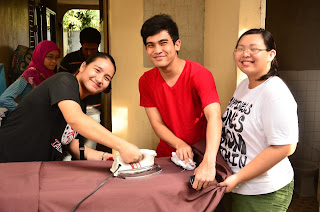We are still working on with the set designs and characters. This is where we
will shoot our experimental video. A house made of wood scraps, a brown
cloth background, a doll, these are just some of our materials for the video.
Just a short brief about the story, it is about house, an ordinary one and sweets as its visitors.
These sweets goes inside the house. The house actually
has legs. When the house gets full, candies tries to push their way in until the
legs gave up and cut loose.
The house symbolizes a person. It have abused itself with many sweets,
the legs could not anymore handle the weight inside and was cut off.
Just like with diabetes, once obtained to many sweets there will be
complications, cutting the leg off, hands, etc.
A picture of me, Ian and Hannah ironing the brown cloth. :)








